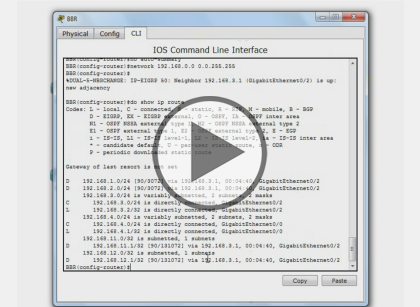Cisco CCNP Implementing Cisco IP Routing , Part 2 of 4: OSPF and Routing
with experts Carlo Tannoury, Kenneth Mayer
Course description
Implementing Cisco IP Routing is a qualifying exam for the Cisco Certified Network Professional CCNP®. This course starts with the Open Shortest Path First Protocol both describing its function as well as how OSPF routes packets and to verify and configure OSPF in a WAN. Next it describes network performance problems, considerations for routing protocols and ends with controlling and routing traffic.
Prerequisites
This is part 2 of the series.
Meet the experts
Carlo has worked in the computer technologies industry since the mid-90s. He is also a certified member of Microsoft, Cisco, ISACA, PMI, CompTIA,
IIC, and EC-Council. He has designed and customized courses for private and public
sectors, including college curriculums, and has worked as a lead consultant engineer
in corporate Cyber security and Information Assurance training since 2001.
As a certified Microsoft Instructor, Ken has focused his career on various security aspects of computer and network technology since the early 1980s. He has offered a wide variety of IT training and high level consulting projects for Fortune 500 companies globally. Through the course of his extensive career, he has taught a full line of Microsoft, CompTIA, Cisco, and other high level IT Security curricula.
Course outline
OSPF
OSPF Terminology (18:55)
- Introduction (00:11)
- OSPF: Open Shortest Path First (01:44)
- Features of OSPF (02:18)
- Characteristics of Link-State Protocol (03:11)
- Advantages (01:32)
- Terminology (03:05)
- Router Types (01:08)
- Internal and Backbone Routers (01:22)
- Area Border Router (02:23)
- Autonomous System Boundary Router (00:56)
- BDR and DR Routers (00:54)
- Summary (00:08)
OSPF Packets (10:19)
- Introduction (00:06)
- What Are OSPF Packets Used For (01:46)
- OSPF Hello Packet: Type 1 (03:31)
- OSPF DBD Packet: Type 2 (01:03)
- OSPF LSR and LSU Packets: Type 3 and 4 (01:11)
- OSPF LSAck Packet: Type 5 (00:49)
- Adjacent Neighbors (00:53)
- Link-State Data Structures (00:48)
- Summary (00:08)
OSPF Routing (05:57)
- Introduction (00:06)
- Planning OSPF Deployment (01:33)
- OSPF Implementation (01:06)
- OSPF Verification (01:51)
- OSPF Documentation (01:10)
- Summary (00:08)
OSPF Verification and Configuration (12:55)
- Introduction (00:07)
- Enable OSPF Routing and Network Identification (01:11)
- Wildcard Mask (01:26)
- Interface Bandwidth Definition and OSPF Router ID (01:01)
- Demo: Configure Single-Area OSPF (01:37)
- Router ID Definition (00:26)
- Demo: Configure Multi-Area OSPF (00:51)
- OSPF Verification: First Method (01:14)
- Demo: Verify OSPF (02:10)
- OSPF Verification: Second Through Fifth Methods (02:27)
- Clearing the OSPF Routing Table (00:13)
- Summary (00:08)
OSPF Network Types (34:50)
- Introduction (00:04)
- Broadcast (01:04)
- DR and BDR (02:13)
- Election Manipulation and Router Priority (01:18)
- Demo: Assign Router Priority (02:46)
- Influencing the Election Process (00:44)
- Demo: Configure Simple Authentication Key (03:15)
- OSPF over MPLS (00:37)
- Demo: Verify Simple Password Authentication (00:55)
- NBMA (03:03)
- Demo: IP Addresses (03:51)
- Demo: Configure OSPF (06:01)
- Demo: Routes (01:22)
- Demo: Branch Routers (07:22)
- Summary (00:08)
Using Multiple Routing Protocols
Routing Performance Issues (04:52)
- Introduction (00:05)
- Usual Routing Performance Issues (01:49)
- Running Different Protocols at the Same Time (01:21)
- Performance Solutions for Routing Protocols (00:53)
- Route Filtering (00:34)
- Summary (00:08)
Multiple Routing Protocols (10:13)
- Introduction (00:05)
- Simple Protocols and Complex Networks (00:36)
- Multiple Protocols Running on One Network (02:03)
- Complex Networks (00:40)
- Redistribution (00:36)
- Demo: Redistribution (01:19)
- Redistributed Routes (01:05)
- How to Select the Best Route (01:26)
- Edge and Core Routing Protocols (00:54)
- Loop Prevention and Redistribution Guidelines (01:16)
- Summary (00:08)
Route Redistribution (44:27)
- Introduction (00:05)
- Redistribution Command (00:53)
- Demo: Redistributing into RIP (03:01)
- Important Route Redistribution Information (00:44)
- Demo: Redistributing into OSPF (03:32)
- Default Metric for BGP, OSPF, and RIP (00:42)
- Demo: Default Metrics (07:13)
- Default Metric for EIGRP (00:34)
- Demo: Apply Metrics for EIGRP (03:07)
- Modifying the Administrative Distance (00:40)
- Demo: Modify Administrative Distance (06:03)
- Changing the Default Administrative Distance (02:29)
- Demo: OSPF Routes (05:26)
- Demo: EIGRP Routes (05:41)
- Demo: (04:02)
- Summary (00:08)
Routing Update Traffic (41:46)
- Introduction (00:04)
- Controlling Routing Updates (01:35)
- Passive Interfaces (00:59)
- Static Routes and Route Maps (01:28)
- Demo: Route Maps (04:41)
- Demo: Route Maps Continued (05:15)
- To Define a Route Map (01:09)
- Various Route-map Commands for PBR (02:08)
- Using Distribute Lists (01:09)
- Demo: Distribute Lists (03:32)
- Define a Filter for Incoming Routing Updates (00:28)
- Demo: Incoming Filter (01:43)
- Define a Filter for Outgoing Routing Updates (00:25)
- Demo: Outgoing Filter (03:40)
- Demo: Prevent Feedback Loops (00:46)
- Demo: Outoging Filter Continued (02:02)
- Prefix Lists (00:41)
- Demo: Avoid Route Feedback (06:31)
- Prefix List Configuration (00:40)
- Demo: Prefix List (02:34)
- Summary (00:08)




